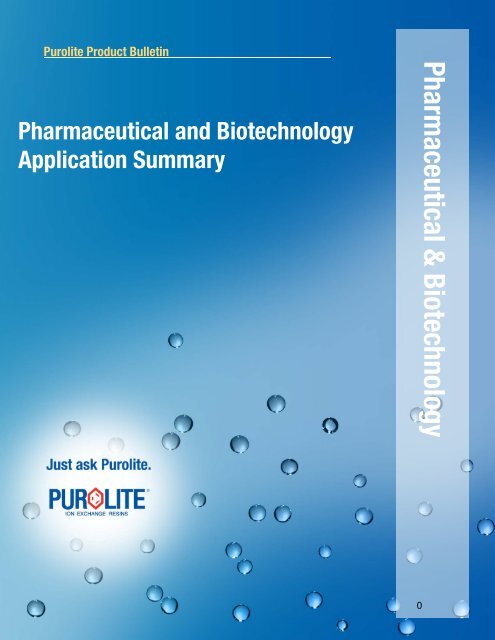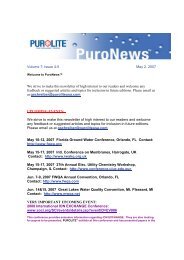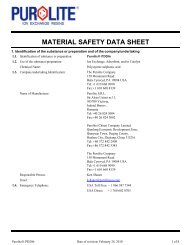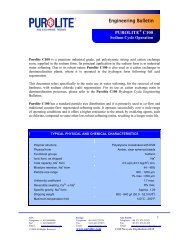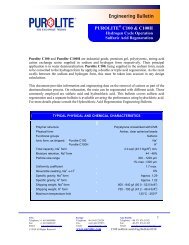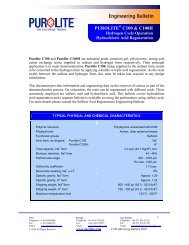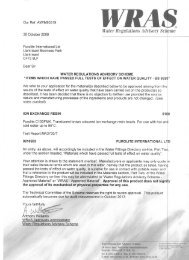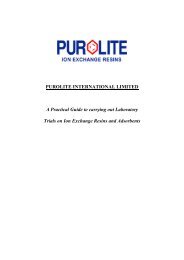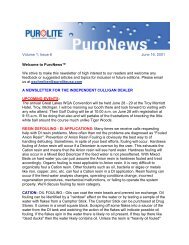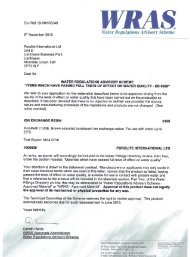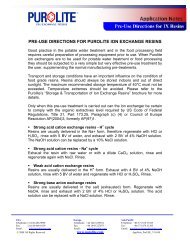Pharmaceutical and Biotechnology Application ... - Purolite.com
Pharmaceutical and Biotechnology Application ... - Purolite.com
Pharmaceutical and Biotechnology Application ... - Purolite.com
Create successful ePaper yourself
Turn your PDF publications into a flip-book with our unique Google optimized e-Paper software.
<strong>Purolite</strong> Product Bulletin_________________________<br />
<strong>Pharmaceutical</strong> <strong>and</strong> <strong>Biotechnology</strong><br />
<strong>Application</strong> Summary<br />
0<br />
<strong>Pharmaceutical</strong> & <strong>Biotechnology</strong>
<strong>Purolite</strong> Product Bulletin <strong>Pharmaceutical</strong> <strong>and</strong> <strong>Biotechnology</strong> Summary<br />
<strong>Pharmaceutical</strong> applications of ion exchange resins<br />
<strong>and</strong> polymeric adsorbents, for which <strong>Purolite</strong> resins<br />
can be used (besides their application as active<br />
pharmaceutical ingredients <strong>and</strong> excipients, <strong>and</strong> as<br />
water treatment media) include extraction <strong>and</strong><br />
purification of enzymes, hormones, alkaloids,<br />
viruses, antibiotics, <strong>and</strong> treatment of fermentation<br />
products, etc.<br />
<strong>Purolite</strong> ® resins used in drug formulations as API’s<br />
or excipients meet the dem<strong>and</strong>s of the American<br />
(USP), European (Ph.Eur.), British (BP) <strong>and</strong><br />
Japanese (JP) pharmacopoeias. Drug Master Files<br />
are held for each, single, listed pharmaceutical<br />
product manufactured in <strong>Purolite</strong>’s facilities, while<br />
resins used in extraction <strong>and</strong> purification<br />
processes, or for the production of water for<br />
injectables, meet the requirements of both the US<br />
Food <strong>and</strong> Drug Administration ( FDA ) <strong>and</strong> the<br />
European Union.<br />
1. ION EXCHANGE RESINS AS ACTIVE<br />
PHARMACEUTICAL INGREDIENTS (API)<br />
Polymeric ion exchange resins are totally<br />
insoluble, <strong>and</strong>, when taken orally, pass through<br />
the human digestive system without being<br />
adsorbed. Ingestion of specific resins, therefore,<br />
has no side effects on the human body (that is,<br />
they are non- systemic). The properties of ion<br />
exchange resins used specifically as active<br />
ingredients are well documented, <strong>and</strong> their<br />
characteristics are clearly defined in various<br />
pharmacopoeias. <strong>Purolite</strong> has Drug Master Files<br />
(DMF’s) for all three API’s listed in this brochure.<br />
1.1. Sodium / Calcium Polystyrene Sulfonate<br />
The kidneys continuously remove potassium. When<br />
kidney function is failing, it may be necessary to<br />
remove potassium from the intestinal tract by<br />
artificial means. This can be achieved by using<br />
Polystyrene Sulfonates, in either the sodium or<br />
calcium form. Sodium Polystyrene Sulfonate is<br />
listed in the USP, Ph.Eur, BP <strong>and</strong> JP , while Calcium<br />
Polystyrene Sulfonate is listed only in the BP <strong>and</strong><br />
JP . As the resins pass through the intestinal<br />
tract they exchange the sodium or calcium on the<br />
resin for potassium. The potassium fixed by the resin<br />
cannot pass into the blood <strong>and</strong> continues through<br />
the body without being released. Introduced into<br />
clinical use in the early 1950’s, such resins are now<br />
widely used in the treatment of acute <strong>and</strong> chronic<br />
hyperkalaemia, in addition to controlling serum<br />
potassium levels in patients undergoing renal<br />
dialysis.<br />
<strong>Purolite</strong> ® C100NaMR <strong>and</strong> <strong>Purolite</strong> ® C100CaMR are<br />
Polystyrene Sulfonate APIs produced in <strong>Purolite</strong>’s<br />
FDA approved <strong>and</strong> cGMP <strong>com</strong>pliant clean rooms.<br />
The powdered resin may subsequently be flavored<br />
by the pharmaceutical <strong>com</strong>pany <strong>and</strong> prepared in<br />
doses to be taken orally.<br />
1.2. Cholestyramine<br />
Cholestyramine is listed in USP, Ph. Eur. <strong>and</strong> BP.<br />
Cholesterol is essential for human <strong>and</strong> animal life,<br />
but an excess of cholesterol in the blood is one of<br />
the most important <strong>and</strong> recognized risk factors in<br />
cardio-vascular disease.<br />
Cholesterol is converted by the liver into bile acids,<br />
which, when discharged into the duodenum,<br />
emulsify ingested fats, thereby assisting digestion.<br />
The bile acids are absorbed through the intestine<br />
<strong>and</strong> are returned to the liver, where they are<br />
converted, through a chain of reactions, to low<br />
density lipoprotein (LDL) cholesterol.<br />
The metabolism of cholesterol is subject to a<br />
delicate balance. This balance can be disrupted to<br />
the point where there is such a high accumulation of<br />
LDL cholesterol in the blood that it precipitates as<br />
cholesteryl esters on the walls of blood vessels,<br />
restricting flow <strong>and</strong> leading to potential heart<br />
attacks. It can, therefore, be advantageous, in such<br />
cases, to reduce cholesterol levels.<br />
<strong>Purolite</strong> ® A430MR is a non-absorbable, nonmetabolisable<br />
anion exchange resin which, by<br />
<strong>com</strong>plexing the bile acids, prevents their reabsorption<br />
<strong>and</strong> allows them to pass through the<br />
body. The reduction of bile acids causes a<br />
depletion of hepatic cholesterol, which, in turn,<br />
stimulates the transformation of LDL cholesterol<br />
into hepatic cholesterol, thereby reducing LDL<br />
Pharma Bulletin December_09 1
<strong>Purolite</strong> Product Bulletin <strong>Pharmaceutical</strong> <strong>and</strong> <strong>Biotechnology</strong> Summary<br />
cholesterol levels <strong>and</strong> lowering the total<br />
cholesterol level in the blood.<br />
The advantage of Cholestyramine containing drugs<br />
over other drugs is that there are no side effects.<br />
Besides the treatment of hypercholesterolemia,<br />
Cholestyramine has other medical applications, such<br />
as: improving diarrheal states by significantly<br />
reducing the activity of endotoxins, treating vitamin<br />
D3 overdose <strong>and</strong>, as recent studies indicate,<br />
regression in arteriosclerosis.<br />
Listed in USP, Ph. Eur. <strong>and</strong> BP as “Cholestyramine”,<br />
<strong>Purolite</strong> ® A430MR is a powdered anion exchange<br />
resin in the chloride form. The powder resin is<br />
flavored by the pharmaceutical <strong>com</strong>pany, <strong>and</strong><br />
prepared in doses to be dispersed in water or fruit<br />
juice for oral consumption.<br />
1.3. Antacid<br />
<strong>Purolite</strong> A830EMR is an antacid used to control<br />
gastric acidity in the treatment of peptic ulcers. It is a<br />
powdered weak base anion exchange resin, in free<br />
base form. <strong>Purolite</strong> A830EMR is an ideal antacid as:<br />
it is insoluble, it is neutral in aqueous suspensions, it<br />
does not irritate the stomach or intestine, it does not<br />
alter the acid-base equilibrium of the body, it<br />
does not alter mineral metabolism, it has no side<br />
effects, <strong>and</strong> it does not cause diarrhea or<br />
constipation.<br />
2. ION EXCHANGE RESINS AS EXCIPIENTS<br />
Ion exchange resins have been used for many years<br />
as excipients. There are a number of examples of<br />
such applications, the most <strong>com</strong>mon being: use as<br />
tablet disintegrants, use in taste <strong>and</strong> odor masking,<br />
<strong>and</strong> use in controlled drug release.<br />
2.1. Polacrilin Potassium<br />
Polacrilin Potassium is typically used as a tablet<br />
disintegrant. The resin, in the dry powdered state, is<br />
incorporated into tablets containing drugs. On<br />
wetting, the resin swells by approximately 150%,<br />
thereby causing the tablet to disintegrate. Introduced<br />
many years ago into tablet formulations as a<br />
disintegration aid, it is still widely used either alone<br />
or, synergistically, in conjunction with other products.<br />
In addition, the use of Polacrilin Potassium renders<br />
the tablets physically stronger <strong>and</strong>, therefore, easier<br />
to press.<br />
Listed in the USP as “Polacrilin Potassium”,<br />
<strong>Purolite</strong> ® C115KMR is a dry, powdered, weak acid,<br />
polymethacrylic cation exchange resin in the<br />
potassium form. <strong>Purolite</strong> ® C115KMR has a<br />
regulated Drug Master File with the FDA.<br />
2.2. Taste & Odor Masking<br />
A number of ion exchange resins <strong>and</strong> adsorbents<br />
can be used to mask the taste <strong>and</strong>/or the odor of<br />
For example, <strong>Purolite</strong> ® C108DR is a special, dry,<br />
carboxylic resin, which is used to mask the<br />
extremely bitter taste of certain cardio-tonics <strong>and</strong><br />
anti-depressants.<br />
2.3. Controlled Drug Release<br />
The controlled release of drugs is a vital factor in the<br />
treatment of many diseases. The selection of the<br />
drug carrier to ensure a steady, uniform, controlled<br />
release is dependent on the kinetics of drug<br />
adsorption <strong>and</strong> desorption, which, in turn, are<br />
influenced by both chemical <strong>and</strong> physical factors.<br />
Ion exchange resins have found use in desired drug<br />
release profiles. There are examples of cation <strong>and</strong><br />
anion resins used not only for solid preparations <strong>and</strong><br />
syrups for oral consumption, but also for lotions,<br />
ointments <strong>and</strong> powders for topical application.<br />
<strong>Purolite</strong> ® C115HMR, also known as Polacrilex, is a<br />
dry, powdered, weak acid, polymethacrylic cation<br />
exchange resin in the hydrogen form that has found<br />
particular application in the controlled, uniform<br />
Pharma Bulletin December_09 2
<strong>Purolite</strong> Product Bulletin <strong>Pharmaceutical</strong> <strong>and</strong> <strong>Biotechnology</strong> Summary<br />
release of nicotine when incorporated into “quit<br />
smoking” aids. Nicotine is adsorbed onto the<br />
powdered resin, which, when <strong>com</strong>bined with the<br />
gum, is released slowly <strong>and</strong> uniformly by chewing.<br />
<strong>Purolite</strong> ® C100HMR is a dry, powdered, strong acid<br />
cation exchange resin in the hydrogen form that has<br />
been grounded into a fine dry powder for taste<br />
masking <strong>and</strong> pharmaceutical carrier applications.<br />
<strong>Purolite</strong> ® C100HMR can also be used in some<br />
Table 1 – <strong>Purolite</strong> Range of API <strong>and</strong> Excipients<br />
Chemical Name Re<strong>com</strong>mended <strong>Purolite</strong> ® Resins <strong>Application</strong><br />
Sodium Polystyrene<br />
Sulfonate<br />
Calcium Polystyrene<br />
Sulfonate<br />
Hydrogen Polystyrene<br />
Sulfonate<br />
C100NaMR<br />
controlled release <strong>and</strong> drug stabilization<br />
applications. For example, it can be used for<br />
controlled release of codeine, noscapine,<br />
dextromethorphane or norephedrine.<br />
Cholestyramine (<strong>Purolite</strong> ® A430MR) <strong>and</strong> Sodium<br />
Polystyrene Sulfonate (<strong>Purolite</strong> ® C100NaMR) are<br />
also two APIs used for controlled release. Both of<br />
these <strong>Purolite</strong> products have Drug Master Files<br />
regulated by Food <strong>and</strong> Drug Administration.<br />
Used in the treatment of hyperpotassemia,<br />
sustained released, taste masking, stabilization<br />
of final dosage.<br />
C100CaMR Used in the treatment of hyperpotassemia.<br />
C100HMR<br />
Cholestyramine A430MR<br />
Polacrilin Potassium C115KMR<br />
Polacrilex<br />
C115HMR<br />
3. ION EXCHANGE RESINS FOR<br />
PHARMACEUTICAL PRODUCTION<br />
The production <strong>and</strong> purification of pharmaceutical<br />
products, including the treatment of water involved in<br />
the process, is one of the most important application<br />
areas for ion exchange resins <strong>and</strong> polymeric<br />
adsorbents.<br />
Used as carrier for sustained released, taste<br />
masking, stabilization of final dosage.<br />
Used for cholesterol reduction, taste masking,<br />
sustained release.<br />
Used as a high performance tablet disintegrant<br />
.<br />
Used as carrier for sustained release.<br />
3.1. Demineralization of Water<br />
Many pharmaceutical processes require softened<br />
or demineralized water in their manufacturing<br />
process. <strong>Purolite</strong> produces the whole range of<br />
cation <strong>and</strong> anion exchange resins required to soften<br />
or totally demineralize water. These resins are<br />
produced to meet FDA <strong>and</strong> EU regulatory<br />
requirements, which specify permitted chemicals<br />
used in their manufacture, maximum release of total<br />
organic carbon (TOC) <strong>and</strong> other chemicals to the<br />
product water, together with analytical methods for<br />
their detection <strong>and</strong> the conditions of use of the resin<br />
products.<br />
When Ultra Pure Water is required, <strong>Purolite</strong><br />
UltraClean resins help producing water of<br />
extremely high purity, with resistivity >18.2 MΩ•cm<br />
<strong>and</strong> very low levels of < 1bbp TOC. This is of<br />
particular advantage to the pharmaceutical industry,<br />
by reducing the volume <strong>and</strong> cost of rinse water when<br />
installing new resin beds <strong>and</strong> reducing outage times<br />
of operating plants. The availability of high purity<br />
water for the process soon after resin changes<br />
Pharma Bulletin December_09 3
<strong>Purolite</strong> Product Bulletin <strong>Pharmaceutical</strong> <strong>and</strong> <strong>Biotechnology</strong> Summary<br />
translates into highly reliable <strong>and</strong> consistent<br />
production.<br />
Disinfection of water produced by the ion exchange<br />
process for pharmaceutical manufacture is often<br />
treated by UV radiation, immediately following ion<br />
exchange or at point of use.<br />
3.2. Drug Purification<br />
Ion exchange resins <strong>and</strong> adsorbents can be used in<br />
many different drug - processing applications, from<br />
extraction, isolation <strong>and</strong> purification to<br />
immobilization <strong>and</strong> stabilization. Purification alone,<br />
for example, may consist of different stages <strong>and</strong><br />
processes: chromatographic separation,<br />
decolorization, deashing, metals removal <strong>and</strong><br />
conversion. The process may also take advantage<br />
of heterogeneous catalytic reactions in the presence<br />
of specific ion exchange catalysts.<br />
The use ion exchange resins <strong>and</strong> selective<br />
adsorbents results in the advantage of higher purity<br />
of the final product, together with minimization of<br />
losses, due to the high capacity <strong>and</strong> selectivity of the<br />
resins.<br />
The most suitable ion exchange resins <strong>and</strong><br />
adsorbents for a given application are selected<br />
on consideration of functional groups (weak or<br />
strong, acid or base, neutral), porosity, pore<br />
diameter, hydrophilic / hydrophobic nature, <strong>and</strong><br />
ability to resist fouling. Often, the final resin selection<br />
is a <strong>com</strong>promise between the capacity, selectivity<br />
<strong>and</strong> elution profile.<br />
Industrial antibiotics production from fermentation<br />
broths is a significant area of both ion exchange <strong>and</strong><br />
synthetic adsorbent use.<br />
3.2.1. Cephalosporin-C<br />
The manufacture of Cephalosporin-C typically takes<br />
place in a number of sequential steps.<br />
A fermentation broth is produced containing 5 to 15<br />
g/l cephalosporin, together with impurities, which is<br />
then passed through a weak base anion exchanger<br />
to remove residual ions <strong>and</strong> to decolorize.<br />
Decolorization is <strong>com</strong>pleted using an adsorbent<br />
(Purosorb PAD 900), prior to <strong>com</strong>pletely<br />
adsorbing Cephalosporin-C onto a second<br />
adsorbent. The Cephalosporin-C is then eluted from<br />
the adsorbent using isopropyl alcohol, <strong>and</strong><br />
converted to the sodium form using a strong acid<br />
cation resin. <strong>Purolite</strong> manufactures all resins <strong>and</strong><br />
adsorbents for these processes.<br />
3.2.2. Streptomycin Sulfate Production<br />
The manufacture of Streptomycin is typically carried<br />
out in the following sequential steps. A fermentation<br />
broth is produced containing Streptomycin in the<br />
presence of impurities. The fermentation broth is<br />
filtered, <strong>and</strong> the clear extract passed through a weak<br />
acid cation bed to extract the Streptomycin. The<br />
Streptomycin is eluted using hydrochloric acid,<br />
decolorized <strong>and</strong> converted to the sulfate form<br />
using a strong base anion resin. Freezing <strong>and</strong> drying<br />
achieve purification.<br />
3.3. Other Processes <strong>and</strong> <strong>Application</strong>s<br />
The extraction of opium alkaloids, enzymes<br />
(such as, lysozyme from albumen), heparin,<br />
together with the extraction <strong>and</strong> purification of<br />
amino acids, <strong>and</strong> the decolorization <strong>and</strong><br />
stabilization of vitamins, are further examples of the<br />
application of ion exchange <strong>and</strong> adsorbent<br />
technology in pharmaceutical production.<br />
Sodium form strong acid cation exchangers are<br />
used to remove calcium ions from collected blood to<br />
inhibit coagulation without the use of additional<br />
chemicals. Carboxylic resins are used to remove<br />
zinc ions from blood plasma. Strong acid cation<br />
exchangers are also used in the analytical<br />
determination of sodium levels in blood, <strong>and</strong> in the<br />
analysis of urine.<br />
<strong>Purolite</strong> ® offer hydrophobic adsorbent products for<br />
adsorption <strong>and</strong> reverse phase chromatography to<br />
separate proteins, insulin, peptides, nucleonic acids,<br />
Pharma Bulletin December_09 4
<strong>Purolite</strong> Product Bulletin <strong>Pharmaceutical</strong> <strong>and</strong> <strong>Biotechnology</strong> Summary<br />
targeted antibiotics <strong>and</strong> many more specific<br />
pharmaceutical <strong>com</strong>pounds <strong>and</strong> solutions.<br />
4. Adsorbent Technology<br />
<strong>Purolite</strong> ® specialty adsorbents, Purosorb <strong>and</strong><br />
Hypersol-Macronet ® , are solid copolymers with<br />
highly porous structures designed to adsorb <strong>and</strong><br />
desorb a wide variety of <strong>com</strong>plex molecules <strong>and</strong><br />
structures in a range of environments. The behavior<br />
<strong>and</strong> degree of adsorbent activity is a function of the<br />
hydrophobicity of the copolymer <strong>and</strong> the degree of<br />
polarity of the solvent environment it is surrounded<br />
by. Typically, non polar molecules adsorb greatest.<br />
Some application examples are:<br />
� Purification of antibiotics, vitamins, drugs,<br />
enzymes <strong>and</strong> chemicals<br />
� Removal of surface-active <strong>com</strong>ponents<br />
� Organic acids purification.<br />
5. Microbeads for Chromatography<br />
<strong>Purolite</strong> supplies a wide range of microbeads for<br />
chromatographic separation. Both Chromalite <strong>and</strong><br />
Hypersol-Macronet ® are available, on request, in<br />
microbead form. Mean diameters of, for example, 5,<br />
10, 30, 50, 100 <strong>and</strong> 200 microns are available in a<br />
choice of functionality, according to the application.<br />
All products are specially purified, <strong>and</strong> made to<br />
narrow size range specifications. These microbeads<br />
are especially useful where separation by sorption<br />
properties control the chromatographic process.<br />
Pharma Bulletin December_09 5
Americas<br />
The <strong>Purolite</strong> Company<br />
150 Monument Road<br />
Bala Cynwyd, PA 19004<br />
USA<br />
Tel +1 610 668 9090<br />
Tel +1 800 343 1500<br />
Fax +1 610 668 8139<br />
Europe<br />
<strong>Purolite</strong> International Ltd<br />
Llantrisant Business Park<br />
Llantrisant<br />
Wales<br />
CF72 8LF<br />
UK<br />
Tel +44 1443 229334<br />
Fax +44 1443 227073<br />
Asia Pacific<br />
<strong>Purolite</strong> (China) Co. Limited<br />
D-705, No 122 Shuguang Road<br />
Hangzhou<br />
Zhejiang<br />
China 310007<br />
Tel +86 571 876 31382<br />
Fax +86 571 876 31385<br />
For further information on <strong>Purolite</strong> products & services<br />
visit www.purolite.<strong>com</strong><br />
0


